A new Big Ask feature from Britain’s World, the Council on Geostrategy’s online magazine, explores whether the Russian Navy remains a credible threat to the United Kingdom after years of setbacks in Ukraine and mounting mechanical failures.
The discussion follows comments by NATO Secretary General Mark Rutte, who joked about a Russian submarine “limping” through the North Sea under escort. Yet several contributors warned that technical issues should not be mistaken for strategic weakness.
Benedict Baxendale-Smith argued that Russia’s continued investment of more than £77 billion in naval modernisation shows clear intent, saying Britain still faces risks from nuclear submarines, long-range missiles, and a “shadow fleet” that threatens undersea infrastructure.
John Foreman, former British Defence Attaché to Moscow, said the Russian Northern Fleet remains “a credible and capable threat,” citing its submarine-launched nuclear forces and modern missile systems. Professor Basil Germond of Lancaster University noted that while Russia would struggle to match NATO in open-ocean warfare, its submarines and civilian “research vessels” are well suited to sabotage and sub-threshold operations that could disrupt British interests.
Some contributors, including defence analyst H. I. Sutton, urged continued caution, pointing to evolving Russian submarine and mine warfare technology as potential dangers in the North Atlantic. Matthew Palmer, a Council on Geostrategy fellow, added that despite poor maintenance and morale, “the Russian Navy remains a dangerous conventional adversary that Britain cannot ignore.”
The consensus, according to the feature, is that while Russia’s surface fleet has weakened, its submarines, covert operations, and capacity for disruption mean it remains a capable and unpredictable force.
Read the full discussion at Britain’s World, the Council on Geostrategy’s magazine on Britain’s role and security.







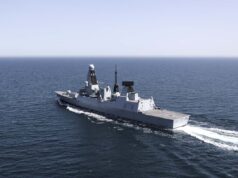

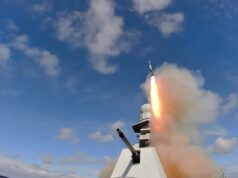
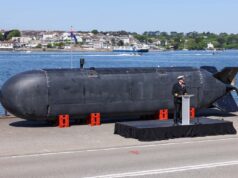
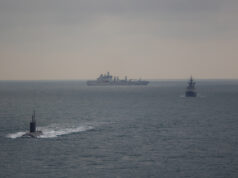
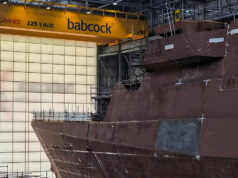

Yes.
No.
Maybe.
There you have it.
The Russian navy is the only serious current naval threat we have to counter. China’s growing fleet is a concern to neighbouring countries and their US alliy but hardly to Europe.
Rebuilding our ASW frigate capability, expanding modernised MCM operations and adding to seabed infrastructure protection should be top priorities.
PeterS, the Chinese Navy is already sailing in our waters, and I fear they intend to keep us in check for the foreseeable future. There appears to be no evidence that the growth of their navy is slowing; in fact, on the contrary, it’s expanding at a worrying rate.
as long as the Russians have the ability to rain down cruise missiles on preselected targets,, they will be a k serious threat although they can’t seem to hit anything with them and rely nowadays on mass drone attacks, drones seem to be very easily shot down and stealth in that area doesn’t appear to be very high on the agenda.threat
The Chinese naval is a threat to the Uk.. where do you think all the stuff we need comes from ? The indo Pacific and western Indian Ocean.. if the UK and china have an issue it’s not going to be decided off the coast of Kent.
China has shall we say very purposefully underplayed its hand for a while now.. it has a saying “hide your strength” it does not follow western ways of deterrent.. it tends to use political warfare to get what it wants and only gives away its power if it needs to…
No other nation hides there SSN production… every other nation shouts to the world every time they launch an SSN, the Chinese go out of their way to hide launching SSNs.. to the extent the west generally has no clue when china commissions a new SSN.
They are the same with their jobbing major surface combatants.. frigate and destroyer numbers take time to assemble and there is generally uncertainty when a frigate or destroyer is commissioned as well as how many of each type of ship they are serially producing.. this is not hiding weakness china has an insane industrial capacity in regards to SSN and surface combatant production.. it’s to hide their strength.
They keep their deployments low key.. but they have steadily been increasing.. over the last decade china has had a permanent presence of 1 destroyer, 1 frigate and one fast replenishment vessel in the western Indian Ocean.. there will also generally be the same size deployment of three ships either heading through the eastern Indian occean to the western Indian Ocean or going back home..so most of the time china will have 6 major surface combatants coming and going around the western Indian Ocean.. they have for the last few years had a semi permanent deployment of 2 ships in the eastern Indian Ocean.. they now and then send a 40,000 ton amphibious vessel to the gulf of Aden area..they have also deployed a IAP sub to the same area. They recently had a joint multilateral airforce exercise in Egypt.
Make no mistake they could put a major task force anywhere they want.. if they so wished they could sail a carrier battle group up the channel to visit Russia.. and they have over 50 frigates and 50 destroyers to escort a CBG as well as 12 large fleet replenishment ships ( 25,000-40,000 ton) 4 smaller 10,000 ton vessels to keep it in beans..
I’ll add that they just commissioned the first non-American supercarrier in the form of the Fujian. They’re pretty much a global force in capability terms.
Well where the hell have you been all day eh ? eh? . It’s bad enough holding the fort and keeping the comments real without losing the main man.
Let us know next time yes ?
Not sure about ‘main man’, but I had a tutorial at uni for most of today. 🙂
Uni ? what do you teach ? I’m thinking of doing a Psycology degree, well that or finance and Tax avoidance, I did think about taking up the Trumbone too but I’m not sure I have the puff.
Teach? I’m not that old, I’m a student. 🙂
Psychology is interesting, I know a few different people who do that. At my uni, the courses you can access depend on the college you’re part of within the uni (for example, colleges like St John’s are known for their medical course in particular), so I don’t know as many people doing finance, but it’s also pretty popular (and future-proof), so definitely one to consider.
Probably not one you would’ve guessed from my interests, but I’m doing an English degree.
Nothing wrong with diverse interests, a bit of ADHD helps 😉
Not all of us are retired or semi retired old duffers with all the time in the world.. right I’m off as I have a busy day of planning what to do with all my excessive retired early time….
But like any Navy. They don’t have all those vessels available on any given day. They will have the same refit and maintenance schedules. Sea trials, work ups. Whatever the Chinese equivalent of FOST is. Crew training, and leave periods to work around like everyone else.
Yep that’s very true.. but I was assuming ( hopefully) the poster I was responding to knows the basics like the rule of three..
One of the frustrating things about avid PLAN watchers like me is China is just about the single most secretive military in the world..so you really cannot understand the operational tempo of each vessel very well they have a watchword of hide your strength.. it’s a problem for the west in making a true assessment of risk as they don’t seem to follow the same paradigm of deterrence as we do.
Even so it’s likely China can generate around 1 carrier, 2 large amphibious flat tops, 20 destroyers, 20 frigates and 20 corvette’s as well as 3-4 fleet supply vessels… it’s probably now got to the point it can actually generate a Competitive SSN ( well trafalgar or flight 2 LA level threat). So it can put some not insignificant task groups out.. it now also has a carrier group capable service and dock in the gulf of Aden area and another western Indian Ocean base on the way.. I would not be surprised if within a couple of years we don’t see a Chinese carrier battle group in the mid Atlantic of if not there in the gulf of Aden
Simple answer yes. It only takes one cruise missile armed sub to get into the Atlantic undetected.
Arrogance has been the cause of many a defeat…..The US has found this out many times…
The HS2 money would be better spent on UK air defences and ASW !
Don’t agree, surely it’s important, vitally so indeed, to get the home guard to Birmingham as soon as possible.
You have it all wrong, HS2 lets the Birmingham Yeomanry deploy rapidly to old oak common and once the Huston end is finished they will be able to rapidly deploy anywhere in Europe 😀
So you think the UK invests too much in infrastructure?
u. knair defences? to protest all the MP’homes?
No… the Russian Navy is not a threat to the UK.
The surface fleet really isn’t a threat outside of the Barents Sea and marginal even there for long I suspect. But I would like to see the Norwegian coast and Greenland’s eastern coast more asset rich to make sure it can be neutralised asap. Submarines are the problem but if they become vulnerable even there then that can help negate their effectiveness as much as possible.
The Russian navy is probably the only direct threat in the world that can threaten the British mainland.
However it’s not much of a threat and even the diminished current Royal Navy is able to counter it much less the entire weight of NATO in the Atlantic.
Russian Navy Combat Ship Inventory (2025)
Aircraft Carrier 1 Admiral Kuznetsov
Battlecruisers 2 Pyotr Velikiy, Admiral Nakhimov (modernized)
Cruisers 3 Slava-class (Marshal Ustinov, Varyag, Moskva lost in 2022)
Destroyers 8 Primarily Sovremenny-class, aging fleet
Frigates 11 Includes Admiral Gorshkov and Grigorovich classes
Corvettes 88 Steregushchiy, Buyan-M, Karakurt classes dominate
Submarines (Total) 58
• Ballistic Missile (SSBN) 11 Borei and Delta IV classes
• Cruise Missile (SSGN) 9 Oscar II class
• Nuclear Attack (SSN) 10 Akula, Sierra, Yasen classes
• Diesel Attack (SSK) 24 Kilo and Improved Kilo classes
• Special Purpose 4 Intelligence and deep-sea missions
Amphibious Ships 19 Ropucha, Ivan Gren, Alligator classes
Mine Warfare Vessels 51 Includes minesweepers and minehunters
Patrol Ships & Boats 31 Offshore patrol vessels and fast attack craft
even though it is so decrepit , and very poorly run t will be neutralised very quickly. even the land capacity which has been utterly trashed by the Ukrainians would be a fish in a barrel shooting game. the losses of their army and air force have been totally ineffective the areas of the russian threat, I believe would come from the vast artillery it has. the outlawing of cluster munitions has reduced the lethality of NATO. for attacking ground targets supply convoys e. t. c
I’m not so sure. Never underestimate your enemy.
Take a look at the bigger picture.
Yes, they have enormous losses in Ukraine, but they keep coming, they keep attacking on many fronts, they are slowly gaining territory.
There is no sign of them slowing down or stopping. Does that look like a country that is on its last legs? I don’t think so.
Russia’s strength is in its ability to absorb huge losses and yet keep this attritional war going.
NATO needs to be ready for a long and costly war meaning:
Improving military industrial capacity and speedy procurement
Having a strong Economy to weather a long war.
Convincing the general public to support the war until it ends.
The main threat from the russian Navy is its Submarine fleet
Also, keep in mind Russia still has a lot of combat aircraft, that do not appear to have been used in Ukraine.
Not all of those ships are present in the Northern Fleet, and so would not be directed against the UK.
Now do it again split between Baltic, Med and Pacific basing…
anyone who downplays Russia’s sub fleet is missing the plot and a threat for being naive
a threat not just for Britain
MATO SSN’S WILL MAKE SHORT WORK OF ANY THAT GETS INTO OPEN WATERS
one would hope, but ocean is big and subs are not easy to find, that is why SSBN is the preferred nuclear weapons delivery system
only 3 NATO members operate SSN (US 22xVirginia + 24xLos Angeles, UK 6xAtute and Fra 3xSuffren + 2xRubis) and Russia has a pretty big sub fleet with around 60 subs (SSBN, SSN and SSK). Atlantic and Indo-Pacific make it a lot of ground to cover for just 3 Nato countries
and Arctic
Yes it is a threat. Even if half is servicable, it is a threat. To deny it is plain stupidity.
As long as we stay (or get back on) the course of rearmament they will still pose a threat, but not an existential one.
The biggest danger is defeatism leading to inaction or declaring victory early and trying to scrape a peace dividend out of the defence budget.
In short: Keep calm and carry on (rebuilding the armed forces.)
The answer is yes.
Honestly I think a very big point everyone keeps forgetting is the Russia china love in.. now we know Russia has struggled to build 1 SSN every 4 years or so and has not been able to build a surface warship bigger than a frigate for a while and those at a snails pace..but they have a new friend a friend with the industrial capacity to potentially build 8 nuclear submarines a year, 1-2 electric boats and from a surface fleet point of view but the entire tonnage of the RN ( including carrier and amphibious vessels ) in the water every couple of years…. And they sell ships cheap to their friends.. 350 million for a new high end ASW frigate.. with long range air defence and land strike.. if china starts supplying Russia Western European navies will have an issue.
Can we buy any on Temu ?
I’m not sure Royal Mail delivers.. they are funny about weapons….
I think it would be interesting to consider just how many conventional or semi conventional electric subs they could build pa if they put their mind to it. You are talking tens. When you consider how many Germany knocked out during WW2 while under fire so to speak. Don’t under estimate.
Interestingly China does not produce that many conventionally powered subs and has not invested in the same Massive infrastructure as has been seen in the nuclear side..
But it’s still at about 3 a year..when it wants to it’s slowed its own down as it build a tranch for export and seems to be moving to a new possibility auxiliary nuclear generator boat.,.
But essentially China at the present state of its industry build a total of about 10-11 submarines a year of all types.. very very scary.
If I could crystalise the issue:
The Northern Fleet’s surface component is in a sorry state. Many of its major surface combatants are pushing four decades in service. It’s sole aircraft carrier is essentially, if not officially, beyond economic repair.
There are exceptions. The Gorshkov-class frigates are potent vessels that could challenge the Royal Navy, given the current lack of anti-ship missiles and surface strike capability on British ships. There are currently three active of this class in the Northern Fleet.
The large Kirov-class battlecruiser, though ancient, has just come out of a significant maintenance period and has received a set of upgrades to bring its armament well-beyond anything in current British service. A prime target, yes, but a ridiculously capable anti-air battery on its own, with the anti-ship missiles to back itself up.
The rest of the surface fleet is fairly ancient, but the RN and RAF are limited in the efficacy against even this battered cohort due to their current lack of an anti-ship missile for the Typhoon, F-35B or Poseidon. Keeping tabs on Russian naval movements would be limited by the RAF’s lack of AEW&C capability. So, despite the ancient enemy ships, the RN would be forced to task one of the limited A-boats to anti-ship duty, or sail a Type 23 frigate within 200km of the enemy ships (with their still very potent anti-ship missile complements) and engage using the Naval Strike Missile, risking a valuable and limited anti-submarine frigate in the process.
The submarine fleets are the RN’s primary challenge. Naval historians are fairly confident in saying that the most modern Russian attack submarines, their nuclear-powered Severodvinsk-class boats (Yasen), are ahead of the Astute-class in most areas, with the exception perhaps being sonar performance and maybe acoustic stealth (though at this point, acoustic stealth is becoming less and less of a factor as most submarines are already virtually undetectable purely through submarine-based sonar technology). The Russians have also led the development of non-acoustic detection measures, fitting their submarines with devices that measure submarine wake particles and have been used (per Russian claims, grains of salt at the ready) to trail American boomers. The Russians also claim to operate a space-based detection system that can track limited numbers of submarines. I know I mentioned the caveat, but there’s little to suggest these non-acoustic detection systems are vapourware – the Russians have a history with great submarine design and practical innovation. The RN now also fits its submarines with a British version that operates on a similar principle, though I don’t believe the Americans do.
There are just three Severodvinsk-class boats in the Northern Fleet. However, they’re backed up by a variety of upgraded Cold War relics. A pair of Oscar-II missile submarines, six of the famed Akula, a pair of Sierra-II, a pair of Victor-III and two each of the Kilo- and Lada-class boats. I exclude the submarine Belgorod, technically part of the Northern Fleet, because of its likely transfer to the Pacific Fleet, and I also exclude the multiple smaller special-operations boats, because it’s not yet entirely certain that they’re coded for combat operations.
All in all, that places the current five and future seven boats of the Astute-class in direct confrontation with 19 Russian attack submarines of various degrees of efficacy and states of readiness. Assuming the rule of thirds, that looks to be maybe six to eight Russian boats operational at any one time, compared to the likely one, potentially zero operational British boats. I acknowledge this discrepancy is due to temporary issues, but applying the rule of thirds to the total planned fleet in the absence of maintenance issues gives two to three active at any one time – at best, a two-to-one disadvantage. This is initially not so bad as might be considered. The British boats are most likely inferior to the Severodvinsk-class, but superior to much of the rest of the Russian fleet. The Russian boats are a mixture of nuclear and diesel submarines as well – whilst useful in littoral operations closer to the Norwegian coast, the bluewater environs of the G-I-UK Gap better suit the speed and endurance of nuclear boats.
The principle advantage that swings the comparison in the favour of the RN is the presence of allies in the North Sea. Any conflict involving Russia and the UK would undoubtably also entail Norway and its Sjøforsvaret (RNoN), whose Ula-class diesel electric submarines, whilst old, are still potent. The Fridtjof Nansen-class frigates are capable air surveillance and anti-submarine assets in their own right, and would integrate with a RN task force. Denmark would likely dispatch an anti-submarine frigate, and Germany would probably dispatch a submarine of their own very capable make. The Netherlands would likely do similar. This would allow NATO to flood the Norwegian Sea and lower reaches of the Arctic with allied submarines, aircraft and frigates in the event of a conflict.
The other major capability that the RN could offer in such a confrontation would be the QE-class carriers, configured for anti-submarine warfare work by hosting a larger complement of Merlin helicopters and using its F-35Bs to provide air cover against Russian naval aviation, which remains a major threat today. This CSG would form a command and control node to coordinate allied ASW efforts, whilst being protected by Type 45 destroyers and presumably allied vessels. However, my fear in relation to the QE-class (and surface action groups in general) is the efficacy of Russian high-performance very-long-range surface-to-surface missiles, like the Zirkon. As currently equipped, British air defence destroyers would be unable to defend against even medium-sized salvos of that missile, which could be launched by surface ships and submarines (using air-based and space-based target indication and detection systems) from well within Russia’s bastion/zone of actual control. Following their planned refits, the destroyers will still lack the capability to reliably engage the Zircon.
This is where the nation I have as of yet left unmentioned enters the picture. The USN currently offers the only air defence capability that could reliably defend a British CSG against that kind of threat. In any likely scenario, even a more ‘hands off’ approach from the American government, I think it is likely that some destroyers would be attached to an allied ASW effort in northern Europe. This is would essentially secure overmatch against the Northern Fleet.
So, to wrap it up – on its own, the RN would struggle to sink the Northern Fleet, and worse, struggle to defend against long-range air attack from submarine and ship-based assets. It’s unlikely that there would be an overwhelming rush of submarines into the Atlantic, however. British attack boats numbers compared to those of the Northern Fleet present less of a chasm than some have made out, and the advantage would lie with the defender. Against NATO’s northern naval powers, the Russian Northern Fleet would struggle to meaningfully threaten allied ships, though without the USN, long-range air attack remains a major threat.
Key steps to be taken:
– Continue to build up unmanned sensor platforms in the G-I-UK gap
– Ensure all twelve SSN-AUKUS are delivered, though ten would be a considerable capability boost
– Increase the planned purchase of Protector drones and fit them with ASW kit
– Continue integrating with Norway, and ensure all eight and all five planned ships are delivered to both nations
– Maintain strong relations with the USA, whilst funding the A30B1NT missile upgrades to British destroyers
– Delay the planned purchase of Mk41 cells for the Type 31 frigates with an eye towards equipping them with limited sonar capability when funds allow
– Procure a small stockpile of Joint Strike Missiles as ana air-launched anti-ship weapon for the Typhoon fleet.
– Cut some of the bloat around new surface-to-surface missile programmes – eg: Project Nightfall, or the Anglo-German missile. Pick a capability, do it well, buy the rest foreign from Korea if required.
Its amazing to me we have been so late in developing or deploying an anti ship missile of any usefulness for so many decades. An anti submarine missile is non existent since Ikara. You could say I’m not full of hubris on the state of play! Its all jam tomorrow.
of course it is, however creaking the russian navy is its going to be superior to the UK’s and probably the combined european fleet, decades of underinvestment and hiding the reality from the public, and that doesn’t even take into account how naval warfare has changed since the arrival of drone ships and other weapons
i could well see british navy capital ships being mothballed in neutral ports, just like the french did in WW2
Not at all an accurate representation.
but highly likely, this won’t be a war fought at sea, even off the coast, it’ll be a war fought on land with sea assets very vulnerable to missiles
You said this:
‘however creaking the russian navy is its going to be superior to the UK’s and probably the combined european fleet’
I’m not quite sure whether you’re a bot, a shill or just cripplingly misinformed, but the Russian surface fleet would be at best a speedbump. Their submarines are more capable, but lack the mass to counter the European navies.
correct ?
In view of the drone threat I’m really surprised they sent the POW on its adventures without the 30mms in place. Now I would go for 40mms. G-up.
Question…
Where is the largest single basing of UK forces personnel in the USA?
Hint – It’s in Virginia.
T he location and what it does they do there gives you an idea of why the stuff they play with Is so important to Allied ASW efforts and why despite all the stories it never
ever went away.
Again ASW is a team game.
Everyone, fixed assets, P8, FF and subs would be playing
‘It never ever went away’ how very true that is. Infact it’s got bigger and been upgraded, to include a former site in the SW of the UK again.
It’s a tad unfortunate that many just see this as an us(UK) versus them, when it’s always been an us(NATO) versus them, with considerable assets available to deploy, not just T23s and the odd Astute.
Of course it is. The main threat though is HMGs inability to build & maintain decent forces to counter the threats in an increasingly dangerous, unstable world. We’re still ticking over at rock bottom(& still considering further cuts or disgraceful delays to rebuilding) rather than building to protect ourselves & deter our enemies. We’re practically open to a sudden surprise mass drone/cruise or ballistic missile attack on our vulnerable, undefended infrastructure.#
We’d all love a peaceful disarmed world, but we’ve been following a disarmament path for decades & made the world far more dangerous.
Any Navy that has negative ill intentions towards Britain, is a threat. Any boat and ship size, below, on and above the water.